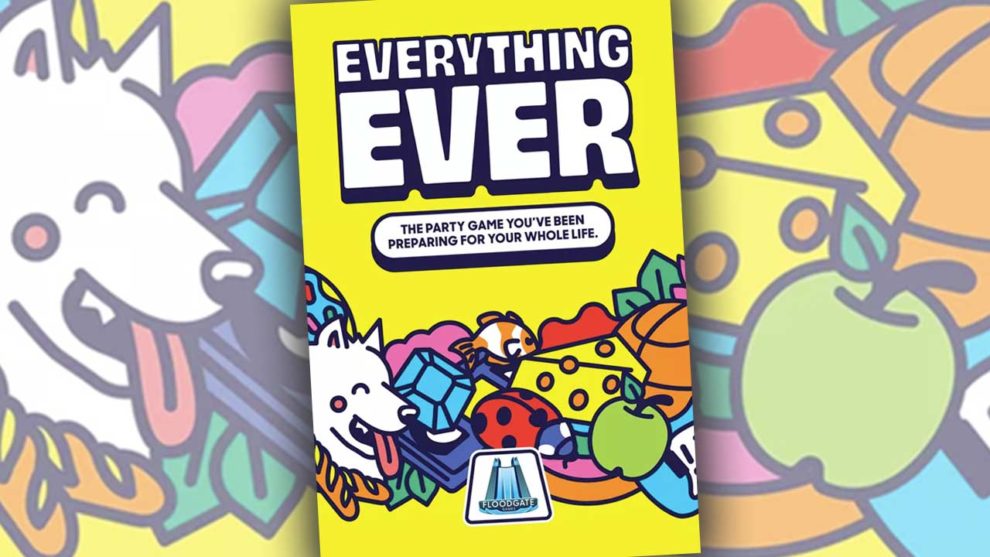The beauty of trying so many games each year is that you know it immediately when you play a winner.
Such was the case with my first play of Everything Ever (2023, Floodgate Games), which took place with Floodgate’s marketing lead, Ian Birdsall, at Gen Con 2023. Ian, along with myself and two complete strangers at the con, played almost a full game while standing at a demo table.
It was the perfect movie, in a sense, even though this was a game in real life: action, drama, comedy, a couple of sweet moments, and rap songs. Ian was gracious enough to provide a review copy after the play, allowing me to see if the gameplay would be replicated in my home environment.
Additional plays only cemented my initial thoughts. Everything Ever is great.

Every Rule
Each of Everything Ever’s 250 cards feature the word Every and then something else from the world you might already know well. “Everything That’s Orange.” “Everything That Has a Hook.” “Every Bird.” “Every Character on ‘The Office.” “Every Disney Villain.” You get the idea.
A draw deck of three cards per player is set in the middle of the table, then the first two cards are revealed. Each player begins play with three cards in hand, and a Judge card that can be used on another player who happens to break one of the game’s very few rules.
On a turn, a player has to name something from each of the two face-up cards within 10 seconds. In those previous examples, let’s say Everything That Has a Hook and Every Disney Villain are the two face-up cards. “Rock climbing tools” and “Maleficent”, respectively, could satisfy these conditions. Then play passes to the next player, who has to say different words for the same cards. Slip up, and a player has to take the card they muffed as a penalty.
Crafty players get to do fun things. Using the same two face-up cards from our last example, let’s pretend the next player says Captain Hook. That meets the criteria of both face-up cards. Besides getting a high five from another player for being so smooth, our Captain Hook friend gets to remove a penalty card, draw a new card into their hand, and add a third category card to the face-up market.
Can’t think of a Disney villain? No sweat. Using one of their cards from hand, players can cover up a category card they can’t answer with a card from their hand that they can answer. The downside, for an unlucky player later on: if a player can’t answer a card on a stack with any other cards, they take all of those stacked cards as a penalty. Yikes!
The game ends when the draw deck is empty; the player with the fewest number of penalty cards wins, with any ties broken by the largest number of cards remaining in hand.

Every Single Player
Everyone I’ve shown Everything Ever has loved it. It works for gamers, it works for non-gamers, it works for families, it works for kids, it works for grandparents, it works for co-workers, it works for neighbors, everyone.
That’s because everyone I know seems to know at least a little bit about popular culture. I licked my chops when a card that required me to know Every Character From The Simpsons. For some reason I have a friend who seems to know Every Song With the Word “Home” in the Title. My wife is strangely good at knowing Every Coffee Brand. Did you know that there are apparently lots of brands of soap? More than two kinds of cheese? Multiple types of hats?
Everyone knows something about all of these categories, and the 10-second timer adds pressure to the proceedings. Everything Ever plays 2-10 players, so you have the right number of players to play in almost any situation. Games usually take about 20 minutes, and can easily be shortened or extended by manipulating the draw deck.
Simple designs like this also work for me; the work here by Nathan Thornton (who also designed the so-popular-I-still-can’t-find-it party game Green Team Wins) is fantastic; the game just seems built to get out of its own way to let players make memories. A special humility-shout-out to Mr. Birdsall, who is credited with the co-development of Everything Ever and didn’t even bother to tell me that when we did our demo play.
Even though the visuals are fairly straightforward, I loved the artwork and graphic design by Danielle Deley here. The cards are striking and colorful, and do a great job of illustrating what the topic of each card aims to be.
I love watching people get creative. “Hook” in the above example could be used figuratively instead of literally; hats aren’t always worn on your head. In each game, a couple of players seem to string together a play that allows them to say one term to meet all the cards on the table. These are the kind of moments that really make games shine. (In my first game, with Every Rapper and Every Joe on the table, Fat Joe was too simple to pass up. One of the strangers gave me a little under-the-table fist bump.)
Games like Everything Ever belong in every gamer’s collection because they are such great ways to kick off a game night. Buy it, people!












Add Comment